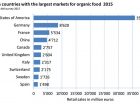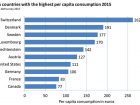
I remember when “organic” was just a basket full of spotted apples in the corner of the produce section. It’s not that anymore.
According to the Organic Trade Association, total USA organic product sales in 2016 reached nearly USD $50 billion, with double-digit growth over the previous five years.
While Switzerland has the highest per capita annual spending on organic (262€), and Denmark has the highest organic market share (8.4% of the total food market), the USA has 48% of the global organic market according to 2015 data from the Research Institute of Organic Agriculture.
Consumers are becoming more aware about how their food is raised. I can’t find a record of the percentage of seafood that was organic, but I suspect it’s close to zero.
Organic standards for aquaculture
Because organic is about the process of production, you will not see organic wild fish on the market. For aquaculture on the other hand, the EU and Canada have organic standards. Internationally, IFOAM (International Federation of Organic Agriculture Movements) is developing an aquaculture standard. The United States has a draft standard, which has been in the works for more than a decade.
Here is a look at what those standards say about RAS.
International
At the IFOAM General Assembly this past November, to provide guidance on writing the aquaculture standard, it was passed that, “Organic aquaculture may include an environmentally integrated recirculation system only if it is primarily based on and situated in a natural environment. It does not routinely rely on external inputs such as oxygen, allows the raised species to spend the majority of their lives in outdoor facilities and preferably uses renewable energy.” If the standard ends up following this guidance, then it won’t have any organic production in RAS. Maybe the fish really do care about nice fresh outdoor air and butterflies fluttering by, but I doubt it.
European Union
The EU organic standard (710/2009) states that, “Closed recirculation aquaculture animal production facilities are prohibited, with the exception of hatcheries and nurseries or for the production of species used for organic feed organisms.” It seems well suited to net pen production. According to Emmanuel Briquet, who helped create the EU standard, the reason Europe excluded RAS was “because of the higher densities at which fish may be reared in RAS, as well as it not representing well enough the predominant European vision of organic production systems.” Briquet and others are working toward having RAS permitted in future EU standards. He says, “they believe that RAS fulfills one of the primary pillars of organic production: ‘respect for nature’, by way of the high level of control on impact that is inherent in RAS.”
United States
The draft of the USA organic standard does allow for RAS; however, according to George Lockwood, who chaired the organic aquaculture workshop at Aquaculture America in Las Vegas this past February, they “have been unable to get the proposed final rule moved from the hold list to the active list.” This means that the USA authority is not presently working on it; thus, the three-hour organic session in Las Vegas lasted only 15 minutes – just like the previous year.
Canada
This past February, the updated Canadian Organic Aquaculture Standard (CAN/CGSB 32-312 2018) was released. It specifically allows for RAS, stating, “Recirculation systems are permitted if the system supports the health, growth, and well-being of the species.” Finally, something to work with. Don’t despair if your market is not Canada: you can farm under the Canadian standard anywhere and sell as certified organic in most global markets including the USA.
Do the requirements work for RAS?
Requirements are numerous and similar to terrestrial organic standards in regard to GMO, antibiotic, hormone, and pesticide use. Unlike the EU, the Canadian standard does not prescribe densities in RAS as these would be impossible to determine for each species of fish at each life stage. Instead, the standard requires proper water quality and conditions that promote overall health of the animals. Health and welfare are central to organic standards and are already at the forefront for many in the aquaculture industry. Organic certification lets the consumer know that as well. With its ability to control water quality, exclude disease, and minimize stress, RAS is well suited to meet all the organic requirements.
Marketing RAS vs Organic
How many of you have tried to market RAS-grown fish? While you were explaining RAS, how many of your customers were like a deer in the headlights? Marketing RAS may be an impossible task. People don’t want to know those details: they just want a piece of healthy, boneless, skinless protein. Yes, there is a demographic that specifically desires fish raised in RAS, but it is so minuscule that RAS capacity already being built could fill this niche. Compare that to organic. Even though the consumer doesn’t read an organic standard, they still know what “organic” means to them: it does not need to be explained. If organic is important to them, they will consider it at the seafood counter, and be willing to pay more.
Does an organic seafood market exist?
I was recently shopping at a Canadian Costco and noticed the excellent price of farmed Atlantic salmon. Yet, the organic chinook salmon price was 68% higher. Was it the chinook or the organic that made it more valuable? I needed a side-by-side comparison. At Aquaculture America, George Lockwood said that Wegmans, a retail chain in the Eastern USA, “since 2010 has been selling EU organic salmon with major premium prices.” To ascertain what a “major premium price” was, I checked pricing at Wegmans, and discovered that EU organic Atlantic salmon fillets ($17.99/lb) were selling for an 80% premium over conventional farmed salmon ($9.99/lb). That is major (though don’t put that in your budget).
Be aware that organic production adds challenges and expenses. You have to believe in organic and be passionate to make it work. Organic seafood is now at the stage of the basket of apples in the corner of the store. However, it won’t be long before consumers, and producers, become aware of it.
Justin Henry is the former general manager of Northern Divine Aquafarms, a sturgeon and salmon RAS in British Columbia, Canada. He now heads up Henry Aquaculture Consult Inc, an international advisory and consulting service for the aquaculture industry. He can be reached at jhenry@aquacultureconsult.com
Print this page

